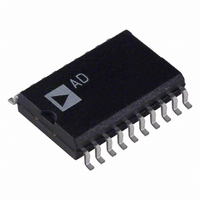AD7701AR Analog Devices Inc, AD7701AR Datasheet - Page 9

AD7701AR
Manufacturer Part Number
AD7701AR
Description
IC ADC 16BIT LC2MOS 20-SOIC
Manufacturer
Analog Devices Inc
Datasheet
1.AD7701ARZ.pdf
(20 pages)
Specifications of AD7701AR
Rohs Status
RoHS non-compliant
Number Of Bits
16
Sampling Rate (per Second)
4k
Data Interface
Serial
Number Of Converters
1
Power Dissipation (max)
37mW
Voltage Supply Source
Analog and Digital, Dual ±
Operating Temperature
-40°C ~ 85°C
Mounting Type
Surface Mount
Package / Case
20-SOIC (0.300", 7.50mm Width)
Available stocks
Company
Part Number
Manufacturer
Quantity
Price
Company:
Part Number:
AD7701AR
Manufacturer:
ADI
Quantity:
2 197
Part Number:
AD7701AR
Manufacturer:
ADI/亚德诺
Quantity:
20 000
Part Number:
AD7701ARS
Manufacturer:
ADI/亚德诺
Quantity:
20 000
Company:
Part Number:
AD7701ARSZ
Manufacturer:
MICROCHIP
Quantity:
1 000
Part Number:
AD7701ARZ
Manufacturer:
ADI/亚德诺
Quantity:
20 000
The term charge-balancing comes from the fact that this system
is a negative feedback loop that tries to keep the net charge on
the integrator capacitor at zero by balancing charge injected by
the input voltage with charge injected by the 1-bit DAC. When
the analog input is zero the only contribution to the integrator
output comes from the 1-bit DAC. For the net charge on the
integrator capacitor to be zero, the DAC output must spend half
its time at +1 V and half its time at –1 V. Assuming ideal com-
ponents, the duty cycle of the comparator will be 50%.
When a positive analog input is applied, the output of the 1-bit
DAC must spend a larger proportion of the time at +1 V, so the
duty cycle of the comparator increases. When a negative input
voltage is applied, the duty cycle decreases.
The AD7701 uses a second-order, sigma-delta modulator and a
sophisticated digital filter that provides a rolling average of the
sampled output. After power-up or if there is a step change in
the input voltage, there is a settling time that must elapse before
valid data is obtained.
DIGITAL FILTERING
The AD7701’s digital filter behaves like an analog filter, with a
few minor differences.
First, since digital filtering occurs after the analog-to-digital
conversion, it can remove noise injected during the conversion
process. Analog filtering cannot do this.
On the other hand, analog filtering can remove noise super-
imposed on the analog signal before it reaches the ADC. Digital
filtering cannot do this and noise peaks riding on signals near
full scale have the potential to saturate the analog modulator
and digital filter, even though the average value of the signal is
within limits. To alleviate this problem, the AD7701 has over-
range headroom built into the sigma-delta modulator and digital
filter that allows overrange excursions of 100 mV. If noise
signals are larger than this, consideration should be given to
analog input filtering, or to reducing the gain in the input
channel so that a full-scale input (2.5 V) gives only a half-scale
input to the AD7701 (1.25 V). This will provide an overrange
capability greater than 100% at the expense of reducing the
dynamic range by one bit (50%).
FILTER CHARACTERISTICS
The cutoff frequency of the digital filter is f
maximum clock frequency of 4.096 MHz, the cutoff frequency
of the filter is 10 Hz and the output rate is 4 kHz.
REV. E
A
IN
Figure 9. SEC Basic Charge-Balancing ADC
R
R
INTEGRATOR
C
1-BIT DAC
+V
–V
REF
REF
COMPARATOR
CLOCK
STROBED
CLK
/409600. At the
TO DIGITAL
FILTER
–9–
Figure 10 shows the filter frequency response. This is a six-pole
Gaussian response that provides 55 dB of 60 Hz rejection for a
10 Hz cutoff frequency. If the clock frequency is halved to give a
5 Hz cutoff, 60 Hz rejection is better than 90 dB. A normalized
s-domain pole-zero plot of the filter is shown in Figure 11.
The response of the filter is defined by:
where
and f is the frequency of interest.
Since the AD7701 contains this on-chip, low-pass filtering,
there is a settling time associated with step function inputs,
and data will be invalid after a step change until the settling
time has elapsed. The AD7701 is, therefore, unsuitable for
high speed multiplexing, where channels are switched and
converted sequentially at high rates, as switching between chan-
nels can cause a step change in the input. Rather, it is intended
for distributed converter systems using one ADC per channel.
However, slow multiplexing of the AD7701 is possible, pro-
vided that the settling time is allowed to elapse before data for
the new channel is accessed.
Figure 11. Normalized Pole-Zero Plot of AD7701 Filter
H x
Figure 10. Frequency Response of AD7701 Filter
–100
–120
–140
–160
( )
–20
–40
–60
–80
s
20
0
–2
1
=
1 0 693
0 00962
x
+
.
=
.
f f
–1
3
x
x
dB
2
8
f
CLK
,
+
+
FREQUENCY – Hz
f
0 240
0 00133
3
= 2MHz
jw
dB
.
.
=
10
0
–j1
j2
j1
–j2
x
f
CLKIN
4
x
+
S1,2 = –1.4663 + j1.8191
S3,4 = –1.7553 + j1.0005
S5,6 = –1.8739 + j0.32272
10
0 0555
.
+
409600
f
CLK
0 000154
f
CLK
.
= 1MHz
= 4MHz
x
AD7701
6
+
x
12
100
−
0 5
.













